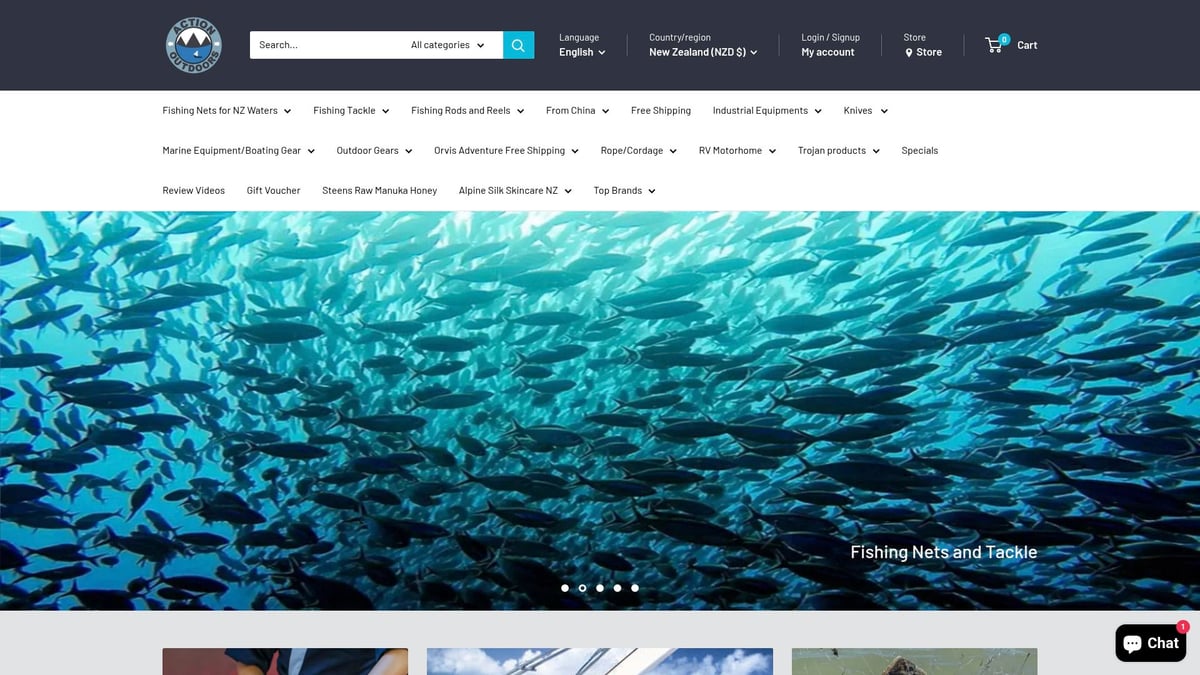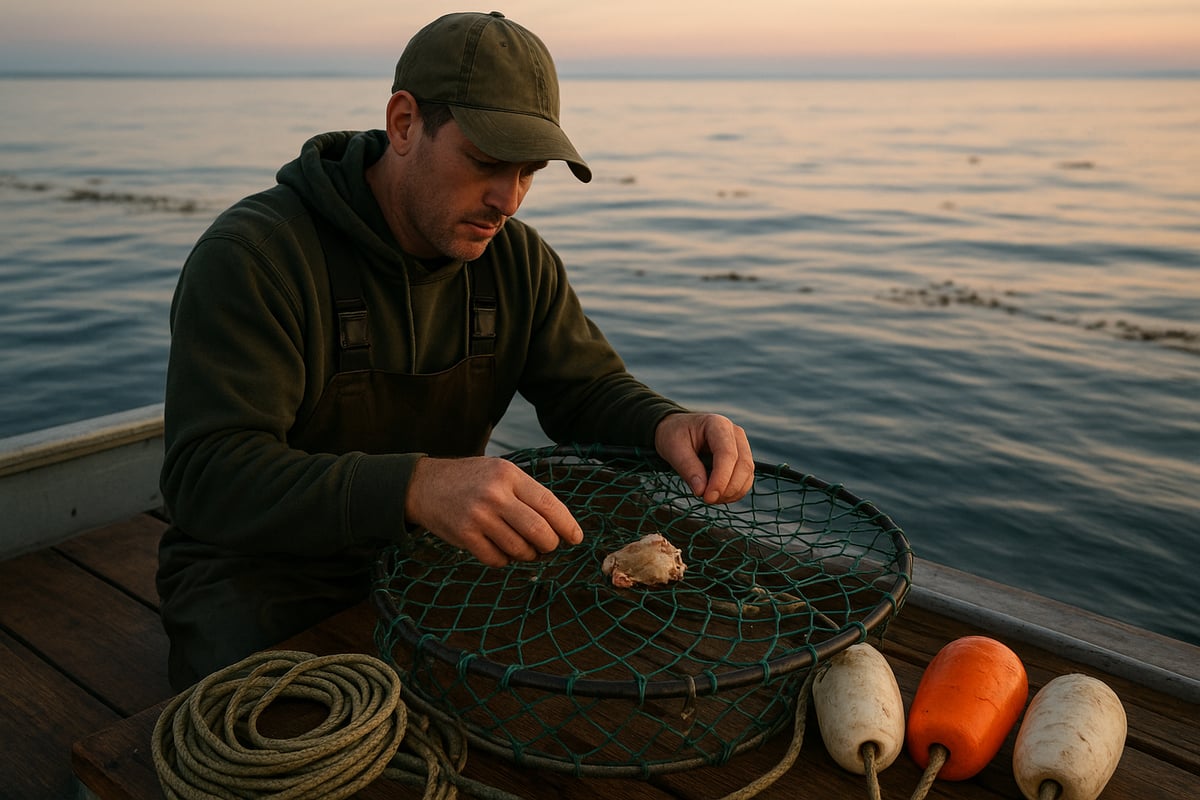Imagine the thrill of pulling a lobster hoop net from the water and discovering a lively catch waiting inside. This accessible technique is gaining popularity because it offers both excitement and success for fishers of all skill levels.
In this guide, you will find the latest tips, updated regulations, and expert strategies for lobster hoop netting in 2025. We cover everything from choosing the right gear and understanding legal requirements to setting up your nets and using the best bait. You will also discover advanced strategies to help you maximize your catch and stay compliant.
Ready to boost your results and fish with confidence? Dive into our comprehensive guide and transform your next lobster outing.
Understanding Lobster Hoop Nets: Basics and Benefits
Lobster hoop netting is an increasingly popular technique among recreational fishers, prized for its simplicity and effectiveness. Whether you are new to lobstering or seeking a more accessible method, understanding the basics and benefits of the lobster hoop net is the first step to a successful catch.

What is a Lobster Hoop Net?
A lobster hoop net is a circular, open trap designed to rest flat on the ocean floor. Unlike traditional lobster pots, which are box-shaped and have rigid entrances, the lobster hoop net features one or more metal or plastic rings supporting a mesh net, with a bait pouch suspended in the center.
This setup allows lobsters to climb onto the net to reach the bait. When the net is retrieved, the rings close upward, trapping the lobster inside. The straightforward design of the lobster hoop net makes it easy to deploy, retrieve, and maintain, which is ideal for recreational anglers. Compared to heavy, cumbersome pots, the lobster hoop net is lightweight and user-friendly, making it a favorite for those seeking a hassle-free lobstering experience.
Why Use Hoop Nets for Lobstering?
The lobster hoop net offers a range of advantages for beginners, families, and seasoned fishers alike. Its accessible design allows anyone to participate in lobstering, even from small boats, kayaks, or piers. The lower cost compared to traditional pots means you can get started without a large investment.
One of the standout features of the lobster hoop net is its gentle approach. The flat net reduces the risk of injury to lobsters and limits bycatch of other marine life. In regions like California and Australia, the lobster hoop net has seen rapid growth in use among recreational fishers. According to recent data, participation in hoop netting has increased by over 25% in California since 2020, reflecting its appeal for safe, sustainable lobstering.
Types of Hoop Nets Available in 2025
In 2025, the lobster hoop net market offers a variety of options to suit different fishing conditions and personal preferences. Traditional models use sturdy steel or plastic rings with nylon mesh, while collapsible nets fold for easy transport and storage. Materials now include coated steel for durability and biodegradable mesh to reduce environmental impact.
Size regulations often dictate ring diameter and mesh opening, so it is important to choose a lobster hoop net that complies with local laws. For instance, some areas require escape rings to allow undersized lobsters to exit. Top-rated models for 2024 and 2025 feature reinforced seams, corrosion-resistant coatings, and user-friendly assembly. For detailed comparisons and real-world feedback, check out Fishing net gear reviews NZ, which covers the latest innovations and trusted brands in the field.
Key Advantages and Limitations
The lobster hoop net stands out for its portability and affordability, making it accessible to a wide range of fishers. Its legal acceptance in many regions adds peace of mind, and the lightweight design allows for easy handling on the water.
However, the lobster hoop net does have some limitations. Its effectiveness is reduced in deeper waters, as it is best suited for shallower coastal zones. The exposed design can attract predators such as crabs or octopus, and there is a risk of theft if nets are left unattended. Despite these drawbacks, the lobster hoop net often outperforms pots in areas where speed, ease of use, and minimal impact are priorities, making it a smart choice for many recreational lobstering situations.
2025 Lobster Hoop Net Regulations and Best Practices
Staying informed about 2025 lobster hoop net regulations is essential for every responsible angler. With evolving rules across popular regions, understanding the latest changes helps ensure compliance, protect lobster populations, and maximize your success on the water.

Updated Lobster Fishing Laws and Permits
In 2025, lobster fishing laws have seen significant updates in key regions like California, New Zealand, and Australia. Recreational fishers must obtain the appropriate permits before using a lobster hoop net. For example, New Zealand requires a valid MPI fishing permit, which clearly outlines size, bag, and possession limits.
In California, the minimum legal size for spiny lobsters, daily bag limits, and possession rules are strictly enforced. Always check your local fisheries website for the most recent changes before heading out. Staying current helps avoid hefty fines and supports sustainable stocks.
Hoop Net Specifications and Legal Standards
Using the correct lobster hoop net is crucial for legal and ethical fishing. Most regions specify approved net dimensions, mesh sizes, and the inclusion of escape rings to allow undersized lobsters to exit safely. Nets must also be marked with identification details to comply with local rules.
For detailed guidelines on legal hoop net requirements, including diagrams and marking examples, consult the California Recreational Lobster Fishing Regulations. Non-compliance can result in gear confiscation and significant penalties, so always double-check your equipment before deploying.
Seasonal and Area Restrictions
Lobster hoop net use is only permitted during open seasons, which can vary by region. For instance, California’s spiny lobster season typically runs from late September to mid-March, while New Zealand’s open dates may shift yearly. Additionally, marine protected areas and no-take zones prohibit all lobster harvesting to safeguard sensitive habitats.
Review local maps and regulations to identify closures or restricted areas before planning your trip. Remember, using a lobster hoop net in off-limits zones can lead to legal action and resource damage.
Ethical and Sustainable Lobster Harvesting
Responsible lobster hoop net fishing means minimizing bycatch and protecting marine environments. Always handle lobsters gently, using wet gloves, and immediately release any undersized individuals or berried females to support population growth.
Best practices include checking your nets frequently to reduce bycatch mortality and avoid habitat damage. Sustainable use of the lobster hoop net helps ensure thriving stocks for future generations of anglers.
Safety Considerations on the Water
Safety should never be overlooked when using a lobster hoop net, especially during night or offshore trips. Essential gear includes life jackets, high-visibility lights, and signaling devices. Always check weather and tide conditions before launching, and inform someone of your plans.
For night fishing, use reflective tape on floats and carry backup lights to stay visible. Adhering to safety protocols not only protects you but also sets a positive example for the lobster hoop netting community.
Choosing the Right Lobster Hoop Net Gear
Selecting the ideal lobster hoop net gear is the foundation of a productive and enjoyable lobstering experience. The right setup ensures you comply with regulations, maximize your chances of a good catch, and stay safe on the water.
Essential Equipment Checklist
A comprehensive lobster hoop net kit includes several key items for efficiency and safety. Essential components are:
- Lobster hoop net (approved size and mesh)
- Durable ropes (measured to water depth)
- High-visibility floats (clearly labeled)
- Bait containers or cages
- Protective gloves
- Measuring gauge for legal lobster size
Each piece of gear supports a smooth and compliant lobstering outing. Investing in quality ensures your lobster hoop net functions reliably throughout the season.
Selecting the Best Hoop Net for Your Needs
Choosing the optimal lobster hoop net depends on where and how you plan to fish. Consider these factors:
- Water depth and bottom type at your chosen spot
- Targeted lobster species and their behavior
- Local regulations regarding net size and materials
Mesh durability is also crucial, as rocky environments can quickly wear out lower-quality nets. Recreational anglers in 2025 favor models with reinforced rings and quick-fold designs, making transport and deployment simple.
Ropes, Floats, and Accessories
Strong ropes are vital for both safety and effective retrieval of your lobster hoop net. Ensure ropes are long enough for your fishing depth and made from materials resistant to saltwater wear.
Floats should be highly visible, labeled with your permit number, and weighted if necessary to remain upright in rough conditions. Handy accessories include bait cages for scent control, glow sticks for night retrieval, and hooks for snag-free lifting.
Bait Choices and Preparation
The right bait can make all the difference in attracting lobsters to your lobster hoop net. Proven options include oily fish heads, mackerel, and squid, which release strong scents underwater.
Homemade bait blends and commercial bait bags are both effective. For best results, secure the bait well in a mesh pouch or cage to extend its longevity and prevent quick loss to smaller marine creatures.
Optional Upgrades and Innovations for 2025
In 2025, new technologies are enhancing the lobster hoop net experience. Biodegradable nets help reduce environmental impact while maintaining performance.
Smart floats equipped with GPS make tracking your gear easier, and quick-release mechanisms speed up retrieval. These innovations, highlighted in recent product launches, are quickly becoming popular among both beginners and seasoned fishers.
Action Outdoors: Your One-Stop Shop for Fishing Nets and Gear
Action Outdoors Limited offers a robust range of fishing nets, including lobster hoop net options tailored for New Zealand waters. Their inventory covers ropes, floats, and all marine accessories needed for a successful trip.

With over 350,000 meters of nets produced annually, Action Outdoors is known for quality, fast service, and NZ-made reliability. For a complete overview of available gear and expert advice, visit their Fishing nets for New Zealand page to find solutions that suit both recreational and commercial needs.
Step-by-Step Guide: Setting Up and Deploying Your Hoop Net
Setting up your lobster hoop net efficiently is the foundation for a productive lobstering session. Following a systematic approach ensures both compliance and success. Let us walk through the process, from initial preparation to post-trip care, so you can maximize your catch and safeguard your gear.

Preparing Your Gear and Location
Before you set out, inspect your lobster hoop net for any signs of wear, broken mesh, or weakened rings. Check that ropes are free of fraying and that floats are securely attached and clearly labeled.
Review your equipment checklist:
- Hoop nets (in good condition)
- Ropes and floats
- Bait containers or cages
- Gloves and measuring gauges
Next, study weather and tide forecasts to avoid rough conditions. Choose launch sites near rocky bottoms, kelp beds, or reefs, as these habitats attract lobsters. Proper planning at this stage helps prevent lost time and optimizes your chance of a successful lobster hoop net deployment.
Baiting and Assembling the Hoop Net
Select a high-quality bait, such as fish heads, mackerel, or squid, and place it securely in the bait pouch or cage. The scent should disperse easily but not allow bait to fall out quickly.
If using a collapsible model, assemble your lobster hoop net according to the manufacturer's instructions, ensuring all components lock into place. Double-check that any required escape gaps or rings are present and sized according to local regulations. A properly prepared net increases your odds of attracting lobsters and staying compliant.
Deploying the Net: Techniques for Success
Lower your lobster hoop net carefully to the seafloor, avoiding tangling by feeding out rope slowly. Position the net flat and ensure it is fully open for optimal entry. Mark the net location with a high-visibility float that is clearly labeled with your details.
For best results, use sturdy ropes and floats designed for marine use. Resources like High-strength ropes and floats can help you choose reliable accessories. Strategic placement and proper marking make it easier to locate and retrieve your lobster hoop net, reducing the risk of gear loss.
Soak Time and Monitoring
Once your lobster hoop net is deployed, allow it to soak for 30 to 60 minutes. This interval provides enough time for lobsters to find and enter the net, but not so long that bait is depleted or predators become an issue.
Monitor your floats for any movement, which may signal a catch or interference. Avoid overcrowding nets in one area, as this can reduce effectiveness. Following optimal soak times, supported by recent studies, helps maximize your catch and minimize downtime between sets with your lobster hoop net.
Retrieving the Net and Handling Your Catch
Retrieve your lobster hoop net with a slow, steady motion to prevent lobsters from escaping. Use gloves to protect your hands as you haul the net to the surface.
Once on board, carefully open the net and remove lobsters. Immediately measure each one with a legal gauge, checking for minimum size and the presence of eggs on females. Release any undersized or berried lobsters promptly, ensuring ethical and sustainable practices during your lobster hoop netting trip.
Troubleshooting Common Problems
If your lobster hoop net becomes tangled, gently shake or untwist it before redeploying. For lost gear, mark your location and search nearby areas, as floats may drift.
To prevent bycatch, use bait cages and check your net regularly. If predators or bait thieves are an issue, try tougher bait containers or adjust your soak time. For additional solutions, consult Frequently asked fishing questions to address common challenges and refine your lobster hoop net technique.
Cleaning and Storing Your Gear Post-Trip
After your session, rinse your lobster hoop net, ropes, and accessories thoroughly with fresh water to remove salt and debris. Lay nets flat or hang them in a dry, shaded area to prevent mold and corrosion.
Store your equipment in a ventilated space, and periodically check for wear or damage before your next outing. Regular maintenance extends the life of your lobster hoop net and ensures reliable performance in future trips.
Advanced Lobster Hoop Netting Strategies for 2025
Mastering advanced techniques is essential for maximizing your lobster hoop net success in 2025. As regulations and lobster habits evolve, staying ahead with proven strategies will help you consistently bring home a better catch. This section explores expert tips for finding prime lobster grounds, deploying your nets efficiently, protecting your gear, and leveraging community wisdom. With careful planning and the right approach, your lobster hoop net experience can become both more productive and rewarding.
Locating High-Yield Lobster Grounds
Finding the best spots for your lobster hoop net is the cornerstone of a successful outing. Focus on areas with abundant structure, such as rocky reefs, kelp forests, and boulder fields. These environments provide shelter and food for lobsters, increasing your odds of a good haul.
Study marine charts to pinpoint underwater features like drop-offs or ledges. Using a GPS unit, mark productive sites so you can return in future seasons. Many experienced anglers also rely on sonar to identify promising terrain.
Regional reports and competitor guides often highlight local hotspots. For example, Southern California and parts of New Zealand are known for productive grounds near protected coves and jetties. By consistently targeting these areas, you can boost your lobster hoop net yield over time.
Timing Your Trips for Maximum Success
Timing can make or break your lobster hoop net results. Lobsters are most active at dusk and during the night when they leave their dens to forage. Plan your trips around these periods for higher catch rates.
Tidal movement is equally important. Aim to deploy your nets around slack tide or the first hour of the incoming tide. These conditions encourage lobsters to move and feed, increasing your chances. Seasonal shifts also play a role, with autumn and early winter often producing the best results.
Stay informed about local opening dates and bag limits by consulting resources like the 2025-2026 California Lobster Regulations. Adhering to these guidelines helps you avoid fines and fish responsibly, ensuring a sustainable lobster hoop net fishery.
Multi-Net Deployment Tactics
Using multiple lobster hoop nets can dramatically improve your efficiency, provided you follow legal limits. Space each net at least 10–15 meters apart to minimize overlap and maximize coverage. This spacing also reduces the risk of tangling lines or losing gear due to shifting currents.
Consider deploying nets in a staggered pattern along the edge of kelp beds or rocky outcrops. This approach covers more ground and allows you to identify which locations are most productive. Keep track of how many nets are in the water to stay within regional regulations.
Efficient deployment and retrieval are key. Use color-coded floats and labeled tags for quick identification, making it easier to manage your lobster hoop net setup in busy conditions.
Stealth and Security: Protecting Your Nets
Lobster hoop net theft is an unfortunate reality in some areas. To minimize risk, use discreet, low-profile floats that blend in with the environment but remain visible to you. Avoid marking nets with overly conspicuous colors or reflective tape.
GPS tracking devices can provide peace of mind, allowing you to monitor your nets’ locations and recover lost gear. Secure your floats with unique identifiers, such as initials or custom tags, to deter theft and comply with local marking rules.
Learning from local incidents and prevention tips shared in fishing communities can further safeguard your investment. Protecting your lobster hoop net gear ensures a more reliable and enjoyable season.
Adapting to Changing Conditions in 2025
Environmental changes and evolving regulations demand flexibility from lobster hoop netters. Water temperature, clarity, and ocean currents all influence lobster behavior. Warmer waters may push lobsters into deeper areas, requiring longer ropes and heavier nets.
Stay updated on regulatory changes affecting gear specifications, such as mesh size or escape ring requirements. For instance, recent NOAA Spiny Lobster Gear Modifications highlight the importance of compliance for both recreational and commercial fishers.
Adapt your lobster hoop net tactics by regularly reviewing local updates and adjusting your approach as needed. This agility helps you stay productive and within the law.
Collaborating and Learning from the Community
The lobster hoop netting community is a valuable source of knowledge. Join local fishing clubs or online forums to share catch reports, exchange tips, and discuss the latest gear innovations. Networking with experienced anglers can reveal hidden hotspots and new techniques.
Participate in group outings or workshops to build skills and stay motivated. Many successful lobster hoop netters credit their growth to advice and camaraderie from fellow enthusiasts. By connecting with others, you can refine your strategies and stay informed about regional trends.
Recording and Analyzing Your Results
Keeping detailed records is a powerful tool for improving your lobster hoop net results. Maintain a logbook or use a dedicated fishing app to track locations, weather, tides, and catch numbers for each trip. Over time, patterns will emerge that inform future decisions.
Analyze your data to identify the most productive spots, optimal soak times, and best bait choices. Adjust your tactics based on these insights to maximize efficiency. Consistent documentation transforms your lobster hoop netting from guesswork into a repeatable, scientific process.
Whether you’re gearing up for your first lobster hoop netting adventure or looking to refine your techniques for 2025, having the right equipment makes all the difference. With Action Outdoors Limited’s trusted, New Zealand-made fishing nets, ropes, and marine accessories, you can fish with confidence and focus on what matters—maximizing your catch and enjoying the experience. Their extensive range is designed for both recreational and commercial fishers, ensuring durability and reliability every trip. If you’re ready to take your lobster hoop netting to the next level, check out the full selection and Buy Now.

